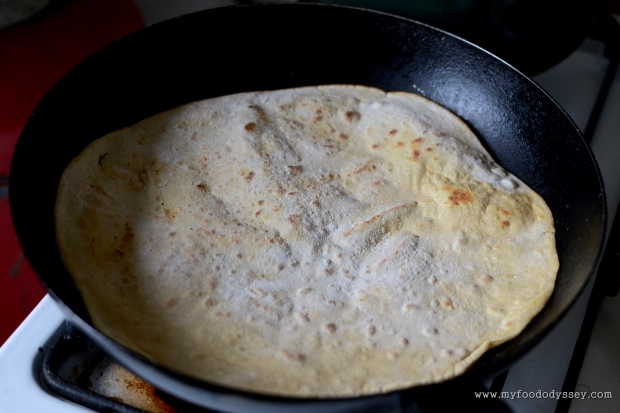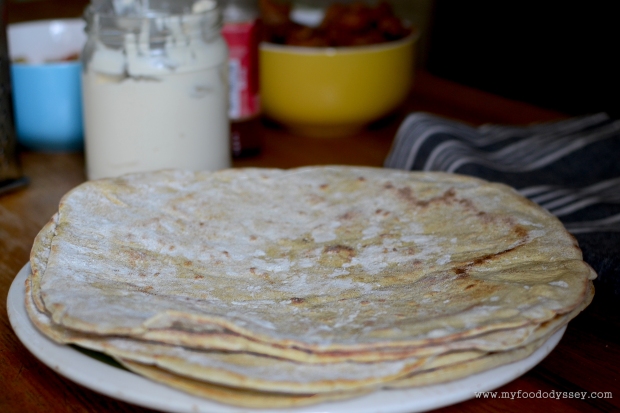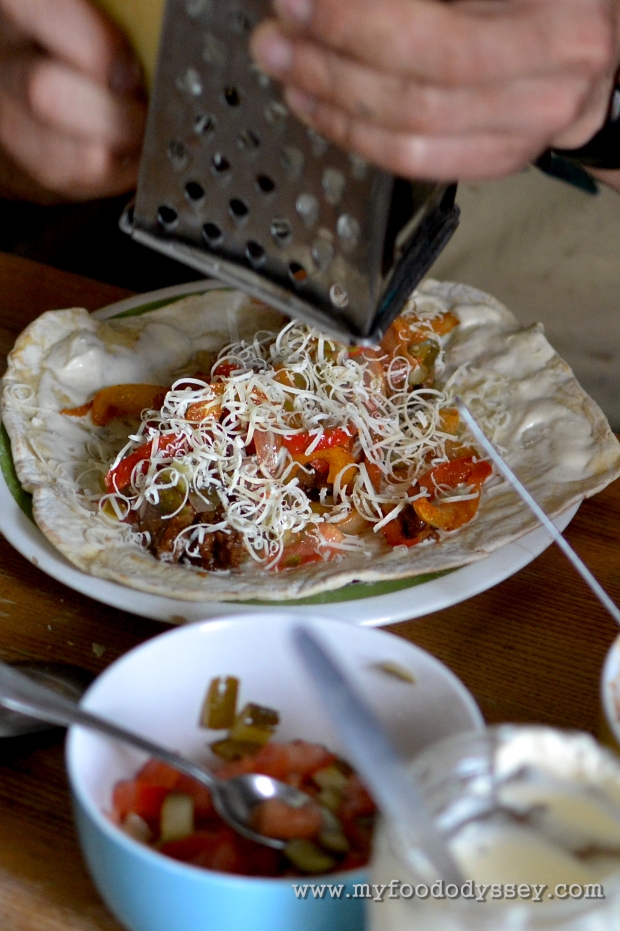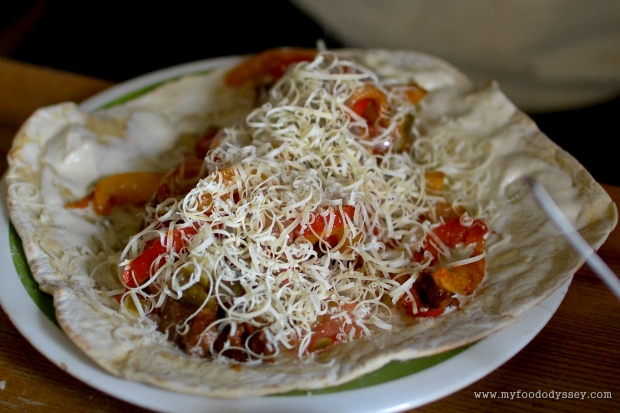Friday Favourites: Homemade Fajitas [Recipe]

I’ll never forget the first time I had fajitas. I was living in Texas and was brought to a restaurant by one of my colleagues to sample the local Tex-Mex cuisine. I had, of course, heard of fajitas but hadn’t tried them and decided to give them a go. The sizzling platter of meat and vegetables, along with a selection of cold toppings such as sour cream, guacamole and grated cheese, that was delivered to each individual diner fascinated me. I absolutely loved the idea of building my own fajita my way, with my chosen ingredients.
Later, when I returned to Ireland, I found it difficult to source the ingredients to make homemade fajitas. A few of the major supermarkets started selling a fajita dinner kit and although it was quite expensive I bought it from time to time as a treat. Things have come a long way since then and most supermarkets now have their own brand of fajita dinner kit. We used to buy them occasionally but, as I started to make more and more of my food from scratch, I found I no longer liked the salsa and used only a fraction of the seasoning mix, resulting in a stash of half-used, rolled up packs of seasoning mix in my pantry. I began to make my own seasoning mix and skipped the salsa completely, so the only element I needed to buy was the tortillas.
Since moving to Lithuania, sourcing fajita ingredients has again become difficult. Because fajitas are not very popular here only major brand names are available, and only in the larger supermarkets. And, relatively speaking, they are very, very expensive. A pack of 8 tortillas costs about €2.30 (US$2.7). I can make 8 fresh tortillas for about €0.30 (US$0.35) – one eighth of the price. And since I also make my own garlic and onion powder, the cost of my homemade seasoning mix is also very low.
Homemade tortillas are incredibly simple to make and the taste and texture are incomparable to store-bought tortillas. They are soft, smoky, floury and full of flavour, reminding me of the authentic tortillas I first had in Texas all those years ago. Homemade tortillas also contain only 5 ingredients. Compare this with the unending list of ingredients in store-bought tortillas. One major brand has 12 ingredients – see below – which I guess is understandable when you consider their insanely long shelf-life. Tortillas are just flat breads and, like any other bread, they should go stale within a few days. Most store-bought tortillas have a shelf-life of up to a year. How can that possibly be? I will never eat a store-bought tortilla again.
Store-bought seasoning mixes also tend to contain a large number of ingredients. I have included the ingredients from one major brand below for reference. Note that the list might not be complete as food companies are not required to list ingredients if they are used in very small quantities. I like to know exactly what’s in my food and don’t need any artificial flavours, colours or preservatives. I avoid all pre-mixed seasonings and instead keep a range of dry spices in my pantry so that I can just create spice mixes as needed. I appreciate that it’s incredibly handy to have your fajita seasoning pre-mixed and ready to go, so I suggest making your mix in large batches which can then be stored in a jar for several months to be used as needed.
We all want our Friday food treats to be simple and tasty. I promise you that this recipe ticks both of those boxes. Remember that it’s just the dinner kit elements – tortillas, seasoning and salsa – that we’re replacing with homemade versions. All of the other elements – chopping meat and vegetables, grating cheese etc. – remain the same regardless of whether you’re using dinner kit or homemade versions. Hopefully, with my “Make Ahead” tips you can actually reduce the time spent cooking on Fridays, even with the homemade versions.
Homemade Fajitas
INGREDIENTS:
For the tortillas:
400 g | 14 oz plain flour (all-purpose flour)
1 tsp baking soda
½ tsp salt
3 Tbsp rapeseed oil (canola oil)
200-250 ml | 7-8.5 fl oz water
For the fajita seasoning:
2 tsp smoked paprika
2 tsp garlic powder
2 tsp onion powder
2 tsp amchoor powder*
1 tsp salt
*Amchoor is dried green mango powder, generally available in Asian markets or large supermarkets. This adds the Tex-Mex limey tang, so do make an effort to find it.
For the salsa:
Salsa is just the Spanish word for sauce and, as such, there is no strict definition of ingredients – it can contain pretty much anything you like. My aim with this salsa was to create a tangy, chunky salsa that had simple ingredients and was very quick to prepare. I use pickles to create the tang typically provided by limes in Tex-Mex cuisine. (There is currently a world-wide shortage of limes and they are consequently quite expensive.) While a little different from what I ate in Texas, this salsa is at least as authentic as that gloopy stuff you get in jars.
2 large ripe tomatoes
2 large gherkins*
Large bunch of fresh coriander, both stalks and leaves (optional)
Toppings and sides:
As with pizza, the world is really your oyster when it comes to fajita toppings. Most people include either meat or seafood (or vegetarian substitutes), a selection of fried vegetables, sour cream, guacamole, grated cheese and Tex-Mex hot sauce. Here are my tips on fajita toppings:
- Allow about 150-200 g (5-7 oz) of meat or fish per adult, depending on appetite. Typical meats include skinned chicken breast, pork steak/chops or beef steak. The most typical seafood used is prawns / shrimp, but chunky white fish such as cod or haddock can also be used.
- Cut your meat or fish into thin, evenly sized strips so that they cook evenly.
- Use about 1 tsp of seasoning mix per 100 g (3.5 oz) of protein. Mixing the seasoning with the protein the night before will allow the flavours to infuse and develop more fully. However, you can mix the seasoning with the protein just before you fry it if you prefer.
- Traditionally, fajitas are served with fried bell peppers and onions. However, you can use any vegetable that can be stir-fried. I often use courgette (zucchini) and mushrooms in addition to the peppers and onions.
- As with the meat, slice the vegetables thinly and evenly, adding 1 tsp of seasoning per 100 g of vegetables. I recommend mixing the seasoning with the vegetables immediately before frying so that the seasoning doesn’t get soaked and lumpy with juices from the vegetables.
METHOD:
For the tortillas:
- Mix the flour, baking soda and salt together in a large bowl.
- Make a well in the centre, add the oil and 200 ml (7 fl oz) of water and bring the mixture together with a metal spoon or spatula. Add more water as needed until the mixture just comes together and is soft but not sticky.
- Turn the mixture out onto a lightly floured board and knead for about one minute. Transfer the dough back into the bowl, cover with cling film (seran wrap) and store in the fridge until needed.
- To cook, cut the dough into 8 evenly sized pieces. (I usually cut in into wedges.).
- On a well-floured board, roll each portion of dough until it is the size of your frying pan. It should be roughly 2-3 mm thick at this point.
- Heat a frying pan* over a high heat. You do not need any oil as there is oil in the dough. When the pan is smoking hot, add your rolled-out dough and cook for about 20 seconds on each side. The cooked tortillas should be very lightly browned with a few dark brown spots.
(NB: Do not use a non-stick frying pan. Heating a non-stick pan without oil will ruin the non-stick surface. Use either cast iron or stainless steal.) - As each tortilla is cooked transfer it to a plate and cover immediately with a clean tea towel. This keeps the tortillas soft and pliable, ensuring you can roll them later when making your fajitas.
- Repeat until all tortillas are cooked. Keep warm under the tea towel until needed.
For the salsa:
- Cut both the tomatoes and pickles into 1 cm (½ inch) cubes.
- Wash and roughly chop the coriander, if using.
- Mix all the ingredients together in a serving bowl and store in the fridge until ready to use. (If storing overnight, I recommend covering the bowl with cling film.)
For the meat and vegetables:
- I use a large saucepan rather than a frying pan when making fajitas so that there is plenty of room to stir the food as you fry. I use separate saucepans for the meat and vegetables as I serve these separately at the table.
- Ensure the oil is smoking hot before you add your seasoned meat.
- When adding the meat, try to distribute it evenly over the base of the saucepan so that as much of the meat as possible has contact with the heat. Once you’ve added the meat do not move or stir it for at least one minute so that the meat seals and browns, creating that lovely smoky taste. Cooking times will vary depending on meat used and how thinly they are sliced. Ensure the meat is cooked through before transferring to a heat-proof bowl for serving.
- Similarly, add your seasoned vegetables to smoking hot oil and stir-fry for 2-3 minutes until they are piping hot but still crunchy. Transfer to a heat-proof bowl for serving.
Building your fajitas:
Serve all the elements on the table in separate bowls, allowing people to build their own fajita at the table. This is the fun part! There are no rules for this – some people add meat first and cream last. My husband, however, likes to add the cream first so that he can spread it around, ensuring there is cream in every bite!
MAKE AHEAD:
As with pizza, many elements of fajitas can be made in advance to save time on fajita night:
- Make a large batch of the seasoning mix (use tablespoons rather than teaspoons to maintain the ratio) and store in a jar in your cupboard. This will keep well for several months. You can just use a few teaspoons of your ready-made mix each time you make fajitas.
transferring to a heat-resistant bowl for serving.The tortilla dough can be made the night before, wrapped in cling film (seran wrap) and stored in the fridge until needed. - Slice the meat and marinate in the seasoning mix the night before. Cover the bowl with cling film (seran wrap) and store in the fridge until needed.
- You can chop most of the vegetables the night before – peppers, onions, courgettes (zucchini) and mushrooms will all keep well stored in an air-tight container in the fridge.
- You can grate the cheese the night before – just be sure to store it in the fridge in an air-tight container so that it doesn’t dry out.
CHEATS:
- Store cupboard: Most of the key ingredients have a long shelf life. Keep flour and the key spices on hand so that you’re always ready.
- Dough: With regard to taste and texture there is nothing to compare with a fresh tortilla. However, if you are tight for time you can use store-bought tortillas or similar bread wraps.
- Salsa: Use store-bought gherkins in the salsa.
- Cheese: Buying grated cheese will save some time.
- Meat: You can buy chicken, pork and beef pre-sliced, ready for marinating.
- Vegetables: Some vegetables also come pre-sliced, either fresh or canned.
EXCUSE BUSTER:
- “Using the meal pack is much quicker.”
Yep, I just can’t argue with that one. However, you’re really not comparing like with like. For one thing, look at all those extra, unnecessary ingredients you’ll be consuming if you use a meal pack. Note that main time saving is in relation to the tortillas, so if you must sacrifice one element in favour of time I suggest it’s the tortillas. That said, the taste and texture of fresh tortillas is incomparable to shop-bought tortillas. - “My family likes the taste of the store-bought seasoning”.
There is a wide variety of seasoning mixes available in the market. Having studied the ingredients in a selection of these seasonings I can see that they all contain different ingredients, but that some ingredients are common across the board. I have based my seasoning mix on the most common and prevailing ingredients in these spice mixes. Of course, one mix can’t mimic the whole range. It’s easy to become accustomed to certain tastes and therefore a new seasoning mix might not feel like the “real thing”. You can adjust the seasoning mix to your family’s tastes adding chilli pepper, ginger powder, ground cumin, cinnamon, extra amchoor powder for extra sourness, extra paprika for extra smokiness, and so forth until you hit upon the exact formula for your family. Read the ingredients on the back of your favourite pack and add in any major spices that are missing, but leaving out all the unnecessary regulator, stabilisers, etc. Provided your spice mix is not too hot you’ll probably find that taste buds adjust to the new flavours quite quickly.
REFERENCE: INGREDIENTS FROM MAJOR COMMERCIAL BRANDS
Tortilla ingredients:
Wheat flour
Water
Rapeseed oil
Raising agent E500, E450
Salt
Humectant (glycerol E422)
Emulsifier: mono-and diglycerides of fatty acids from plant origin (E471)
Acidity E296
Preservatives E282, E202
Sugar
Thickener E412
Antioxidant E300
Fajita seasoning ingredients:
Sugar
Dehydrated Vegetables (Onion, Garlic)
Salt
Flavourings (contains Wheat)
Smoke Flavouring
Hydrolysed Soy Protein
Yeast Extract
Spices (Black Pepper, Cayenne Pepper, Ginger)
Acidity Regulator (Sodium Acetate, Citric Acid)
Colour (Caramel)
Salsa ingredients:
Tomato (61%)
Onions (16%)
Green Peppers (10%)
Tomato Paste
Salt
Vinegar
Onion Flakes
Sugar
Onion Powder
Lemon Juice Concentrate
Guajillo Pepper
Garlic Powder
Spices
Acidity Regulator (Citric Acid)
Like what you see? Then please subscribe to My Food Odyssey. Alternatively you can follow me on Facebook, Twitter and Pinterest.







































I discovered your blog after seeing your HHI episode. I am living in Southern Africa and by necessity have to make a lot of things from scratch. I really need to start making my own tortillas and your recipe has inspired me. I don’t think I’ve ever seen the oil you recommended in our local shops. I usually have Extra Virgin Olive Oil, Avocado Oil, Macadamia Nut Oil, and Coconut Oil on hand. Which would you recommend? Thanks in advance!
LikeLiked by 1 person
Hi Elysa. I think rapeseed oil is called canola in SA and some other countries. (I have updated the recipe now to add this.) Of the oils you listed the only one I would recommend for this is the EVOO. The avocado is a bit too rich (and green!) and the coconut is not suitable as it is solid at room temp. I’m afraid I haven’t tried macadamia nut oil but I reckon any nut oil might be too rich. If you can find a “first cold pressed” canola oil or sunflower oil those would be best, followed by the EVOO. (Note that “first cold pressed” is the seed equivalent of “Extra Virgin”.) The reason I recommend these is because they are milder in flavour and colour and have a higher “smoke point” than olive oil.
I hope you try the recipe and enjoy the results. To me they are far superior to shop-bought tortillas, so I don’t think you’ll be sorry!
LikeLike
Thanks so much, June!
LikeLike
My son was in Lithuania last week on business, and was taken out for a traditional Lithuanian dinner. The starter was beetroot and milk soup, and having googled it, I found your blog. I am having fun reading it, and will certainly be back to read more …… and I have sent the link to my son, as he is a good cook and may want to try making the soup for himself.
Best wishes from Anne, in the Glorious Scottish Borders.
LikeLiked by 1 person
Thanks for your kind comments, Anne! I hope your son enjoys the soup – I think it’s the most popular recipe on my site. Hope the weather is good in beautiful Scotland!
LikeLike
This looks delicious! Can I have one please?
LikeLiked by 1 person
Sure! Stop by any time! 😉
LikeLike